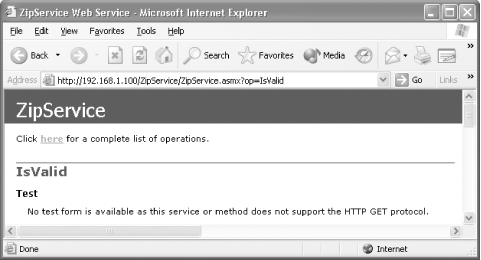10.4 Compatibility
| only for RuBoard |
Document/literal and RPC-encoded SOAP were already briefly discussed. The terms themselves mean that the SOAP body can be either RPC-based or Document-based, and the method parameters described within the SOAP body are either Literal or Encoded .
Literal maps method parameters to an XSD schema for each parameter. Each parameter has an element that contains a literal string describing type. These types are mapped to the xsd namespace defined in the SOAP envelope:
<!-- Used by ASP.NET Web services --> <?xml version="1.0" encoding="utf-8"?> <soap:Envelope xmlns:xsi= http://www.w3.org/2001/XMLSchema-instance xmlns:xsd=http://www.w3.org/2001/XMLSchema xmlns:soap= http://schemas.xmlsoap.org/soap/envelope/ > <soap:Body> <IsValid xmlns="http://192.168.1.100/"> <City>string</City> <Zip>string</Zip> </IsValid> </soap:Body> </soap:Envelope> Encoded means that the parameters are encoded as described in Section 5 of the SOAP specification. [2] A complex type is defined for each parameter:
[2] This specification can be found at http://www.w3c.org.
<!-- Used by remoting and other non-.NET SOAP clients --> <?xml version="1.0" encoding="utf-8"?> <soap:Envelope xmlns:xsi= http://www.w3.org/2001/XMLSchema-instance xmlns:xsd= http://www.w3.org/2001/XMLSchema xmlns:soapenc= http://schemas.xmlsoap.org/soap/encoding/ xmlns:tns= http://192.168.1.100/ xmlns:types= http://192.168.1.100/encodedTypes xmlns:soap= http://schemas.xmlsoap.org/soap/envelope/ > <soap:Body soap:encodingStyle="http://schemas.xmlsoap.org/soap/encoding/"> <tns:IsValidRPC> <City xsi:type="xsd:string">string</City> <Zip xsi:type="xsd:string">string</Zip> </tns:IsValidRPC> </soap:Body> </soap:Envelope>
While Document can use Literal or Encoded parameters, RPC-style SOAP is limited to encoded parameters. To create Document/encoded SOAP, use the SoapDocumentMethod attribute on the web method:
<WebMethod( ), SoapDocumentMethod(Use:=SoapBindingUse.Encoded)> _ Public Function IsValidEncoded(ByVal City As String, ByVal Zip As String) As Boolean
Example 10-6 contains a listing of ZipService that provides methods using all three styles.
Example 10-6. ZipService encoding test
'vbc /t:library /r:System.dll '/r:System.Web.Services.dll ZipService.vb Imports System Imports System.Web.Services Imports System.Web.Services.Description Imports System.Web.Services.Protocols 'Inherits from MarshalByRefObject for .NET Remoting <WebService(Namespace:="http://192.168.1.100/")> _ Public Class ZipService : Inherits MarshalByRefObject <WebMethod( )> _ Public Function IsValid(ByVal City As String, _ ByVal Zip As String) As Boolean Return True End Function <WebMethod( ), SoapRpcMethod( )> _ Public Function IsValidRPC(ByVal City As String, _ ByVal Zip As String) As Boolean Return True End Function <WebMethod( ), SoapDocumentMethod(Use:=SoapBindingUse.Encoded)> _ Public Function IsValidEncoded(ByVal City As String, _ ByVal Zip As String) As Boolean Return True End Function End Class
The service description pages generated by ASP.NET allow inspection of the SOAP for each method.
Even if using a web service from remoting is not desired, it is still a good idea to use the SoapRpcMethod attribute for interoperability. There are quite a few SOAP clients out there that expect RPC-encoded SOAP. Supplying the attribute doesn't hurt because ASP.NET supports both encoding styles.
Also, a few SOAP toolkits do not know how to deal with the HTTP/Post and HTTP/Get bindings generated by ASP.NET. For these SOAP clients to use the web service, you might need to disable these bindings by placing the following entries in Web.config :
<system.web> <webServices> <protocols> <remove name="HttpPost" /> <remove name="HttpGet" /> </protocols> </webServices> </system.web>
There is an upside and a downside to doing this. While the web service is now potentially available to many more SOAP clients, ASP.NET uses the HTTP/Get to create the testing form for the web method. As shown in Figure 10-5, it will no longer be available when the bindings are removed.
Figure 10-5. Web method test is no longer available when HTTP bindings are removed

| only for RuBoard |
EAN: 2147483647
Pages: 112